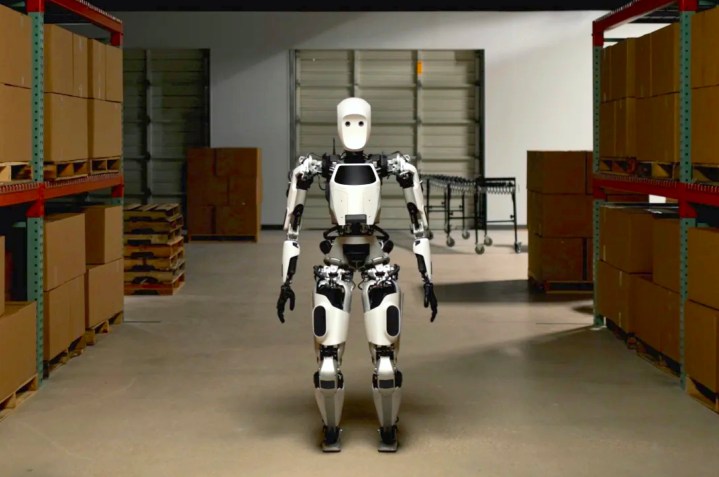
Another humanoid robot has come sniffing for your job.
Created by Texas-based Apptronik, the new robot worker, called Apollo, certainly looks like the real deal and is far from the kind of clunky, awkward contraptions that sometimes appear at such unveilings. That’s probably because Apollo is the culmination of Apptronik’s experience and expertise in creating more than 10 other robots, among them NASA’s Valkyrie humanoid robot.
The company says Apollo already has the skills and dexterity to work competently in warehouses and manufacturing plants, though it adds that future improvements to its design could see it helping out in industries such as construction, oil and gas, electronics production, retail, home delivery, and care.
Apptronik this week posted a bunch of videos showing off the humanoid robot’s abilities, which currently include unloading, lifting, carrying, and stacking objects. You can watch some of the footage below:
Apollo stands at 5 foot 8 inches and tips the scales at 160 pounds. The robot can handle payloads of up to 55 pounds and operate for four hours on a single charge. Fortunately for its employer, there’ll be no extended coffee breaks for Apollo while it waits to charge, as its battery can be quickly swapped out for a fresh one.
As shown in one of the videos, the robot features digital displays on various parts of its body to communicate with its human bosses or nearby human workers, if there are any. Speaking of co-workers, Apollo is fitted with various sensors to ensure that it steers clear of people in the vicinity, or other nearby obstacles.
The package also includes a software suite offering point-and-click control of Apollo and configurable automated behavior geared toward the completion of various tasks.
Those following the development of humanoid robots will have noted some similarities between the in-development Tesla Bot and Xiaomi’s CyberOne robot. Hyundai-owned Boston Dynamics has also made impressive progress in developing highly versatile, mobile robots for the workplace.
Various limitations with humanoid robot designs mean that they have yet to make a big impact in industry settings, with fixed robots built for specific tasks more likely to be deployed.
“As labor challenges and employment trends continue to impact our economy, we need to fundamentally change the way we think about work, particularly in the warehouse and the supply chain,” Jeff Cardenas, co-founder and CEO of Apptronik, said in a release. “People don’t want to do robotic, physically demanding work in tough conditions and they shouldn’t have to. Humanoid robots are not just an answer to this challenge, they are a necessity — and because of our deep robotics lineage, Apollo is uniquely positioned to quite literally step in and make an impact.”
Pricing for Apollo has yet to be revealed but Apptronik invites people to get in touch if interested in deploying the robot at their workplace.
Editors' Recommendations
- Texas airport to get a 420-pound security robot
- Amazon’s new humanoid robot will not take human jobs, company insists
- Deep-diving robotic sub could be last hope for lost Titanic tourists
- Robots deployed to assist New York City police … again
- CyberOne robot is Xiaomi’s answer to Tesla Bot


